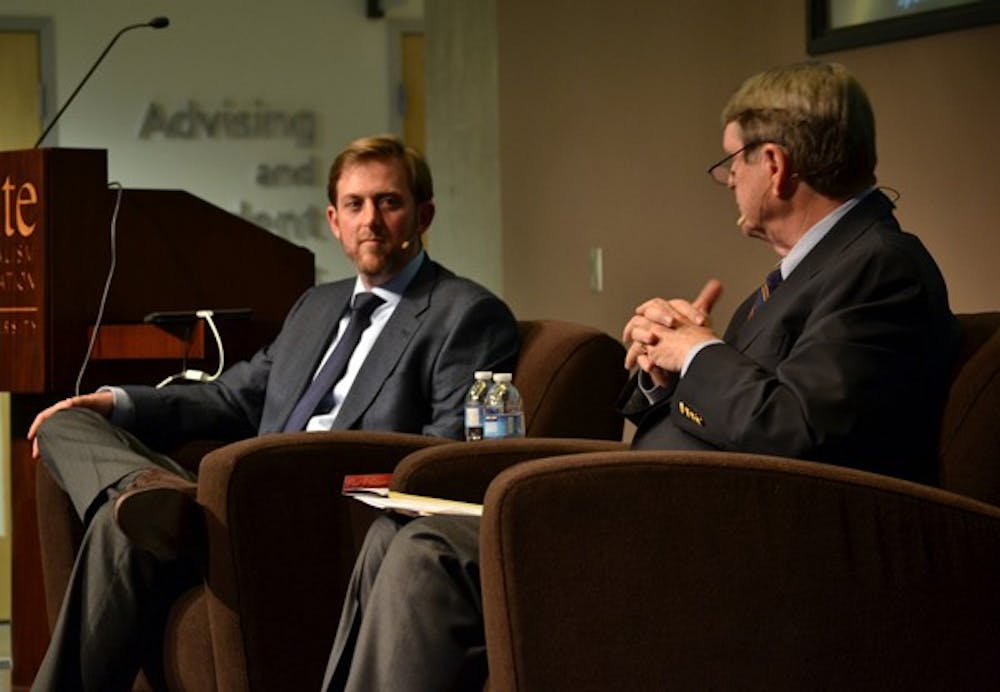 Steven Ginsberg, the national political editor for The Washington Post, discusses the upcoming presidential election with professor of journalism Leonard Downie Jr. The discussion was prompted by the annual Paul J. Schatt Memorial Lecture in honor of The Arizona Republic editor and ASU journalism professor. (Photo by Brittany Lea)
Steven Ginsberg, the national political editor for The Washington Post, discusses the upcoming presidential election with professor of journalism Leonard Downie Jr. The discussion was prompted by the annual Paul J. Schatt Memorial Lecture in honor of The Arizona Republic editor and ASU journalism professor. (Photo by Brittany Lea)The 2012 presidential race has required sifting through too much information rather than searching for more, a top Washington Post editor said Thursday evening.
Steven Ginsberg, the national political editor for The Washington Post, spoke to a crowd of students and residents at the Walter Cronkite School of Journalism and Mass Communication on the Downtown campus about the complicated tasks involved in accurately following politics.
Ginsberg, who was appointed to his current position in 2011, is using his position to bring political coverage into the digital age, he said.
When there is a breaking news story, the very last medium addressed is the newspaper, Ginsberg said.
“We want people not to just come to the paper the day after and find out what happened, we want people to be there,” Ginsberg said.
In covering the 2012 race, The Post has incorporated digital tools such as a live blog of the campaign trail, Instagram photos to document the candidates and, as of six weeks ago, an iPad application.
The goals of the iPad app are to disseminate information about campaigns in a simple, need-to-know format and to present news in an eye-catching way, Ginsberg said.
“Everything you didn’t know passes as news these days,” Ginsberg said. “You just have to stop and figure out if it’s something worth paying attention to.”
One of the most popular new forms of campaign coverage this year is the Pinocchio rating, Ginsberg said.
The Post employs a fact-checker whose only job is to verify the accuracy of politicians’ statements. If a politician lies, the app rates the lie on a scale from one to four using Pinocchio icons.
On the iPad app, politicians’ claims can be seen in real time alongside a growing Pinocchio nose.
“The moment the politician starts lying, Pinocchio’s nose starts to grow,” he said.
The fear of getting a Pinocchio has become a common point of conversation among politicians and has even inspired some to stop telling the same lie over and over again, Ginsberg said.
Two weeks ago, President Barack Obama received four Pinocchios from The Post. Obama said that Grover Cleveland, 22nd and 24th president of the U.S., hated technology and was against the telephone. According to the White House historian, Cleveland installed the first telephone in the White House, Ginsberg said.
Dan Shein, a retired Phoenix resident said he is worried that people are too engrossed with 30-second sound bytes of what’s going on in politics and that the small amount of information isn’t always credible.
“There’s so much out there, sometimes it’s hard to determine what’s accurate,” Shein said.
Journalism junior Anastasia Landeros said news outlets could do a better job of reaching people who have a lesser interest in politics.
The iPad app is more visual and interesting, Landeros said.
“That route might work to help bring people into politics who aren’t really interested,” Landeros said.
The app includes a graph for each issue that shows where this year’s Republican candidates stand on the issue, using icons of their faces.
The graph allows people to gauge how each candidate differs on various issues, Ginsberg said.
The Post still writes in-depth articles examining issues and politicians, Ginsberg said.
It’s just a matter of knowing which aspects deserve that amount of attention, he said.
“The universal desire to know more still exists,” Ginsberg said.
Reach the reporter at michelle.peirano@asu.edu
Follow us on Twitter or like us on Facebook. Click here to subscribe to the daily State Press email newsletter.




